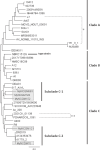Highly carbapenem-resistant Achromobacter xylosoxidans harboring blaNDM-1 in Myanmar
- PMID: 40387330
- PMCID: PMC12210851
- DOI: 10.1128/spectrum.00080-25
Highly carbapenem-resistant Achromobacter xylosoxidans harboring blaNDM-1 in Myanmar
Abstract
Achromobacter xylosoxidans is a multidrug-resistant, non-glucose-fermenting, gram-negative bacterium with intrinsic resistance to many antimicrobial agents. Between 2016 and 2017, five A. xylosoxidans isolates were obtained from five patients at three hospitals in Myanmar. Minimum inhibitory concentrations (MICs) against various antimicrobial agents were determined using the microdilution method. Whole genome sequencing was performed with the MiSeq and MinION platforms. Resistance genes and their surrounding structures were identified and compared. All five isolates were resistant to amikacin and aztreonam. Among them, one isolate, MyNCGM749, was resistant to imipenem and meropenem with MICs of 256 µg/mL and amikacin with MIC of >512 µg/mL but intermediate to ciprofloxacin with MIC of 2 µg/mL. The isolate carried blaNDM-1 encoding metallo-β-lactamase, blaPSE-1 encoding extended-spectrum-β-lactamase, and blaOXA-114 (encoding intrinsic -β-lactamase present in A. xylosoxidans), along with five aminoglycoside modification encoding genes including aac(6')-Ib, aph (6)-Id, aph(3'')-Ib, ant(4')-Iib, and aph(3')-VI on its chromosome. The genetic structure surrounding blaNDM-1 contained four IS91 elements identical to those found in carbapenem-resistant Pseudomonas asiatica isolates in Myanmar. This is the first report of A. xylosoxidans in Myanmar. Although A. xylosoxidans harboring blaNDM-1 has been reported in a single strain from India, its genomic details have not been previously described. This study indicates that the blaNDM-1-containing structure flanked by IS91 is spreading among gram-negative, non-glucose-fermenting bacteria in Myanmar and neighboring countries.IMPORTANCEAchromobacter species were originally environmental organisms that became opportunistic pathogens with multidrug resistance. Achromobacter xylosoxidans is associated with nosocomially acquired infections affecting multiple organ systems, including the respiratory and urinary tracts, and, less commonly, the cardiovascular and central nervous systems. To date, carbapenem-resistant A. xylosoxidans carrying carbapenemase-encoding genes has been reported in several countries, including Greece, India, Italy, Japan, Korea, Libya, and the Netherlands. In this molecular epidemiological study on A. xylosoxidans in Myanmar, we identified the genomic structure surrounding blaNDM-1, flanked by IS91. This structure may facilitate the spread of non-glucose-fermenting gram-negative bacteria, such as Achromobacter, Pseudomonas, and Stenotrophomonas species, in Asian countries.
Keywords: Achromobacter xylosoxidans; blaNDM-1; carbapenemase; multidrug resistance.
Conflict of interest statement
The authors declare no conflict of interest.
Figures


References
-
- Ahmed MS, Nistal C, Jayan R, Kuduvalli M, Anijeet HKI. 2009. Achromobacter xylosoxidans, an emerging pathogen in catheter-related infection in dialysis population causing prosthetic valve endocarditis: a case report and review of literature. Clin Nephrol 71:350–354. doi: 10.5414/cnp71350 - DOI - PubMed
MeSH terms
Substances
Grants and funding
LinkOut - more resources
Full Text Sources
Medical

